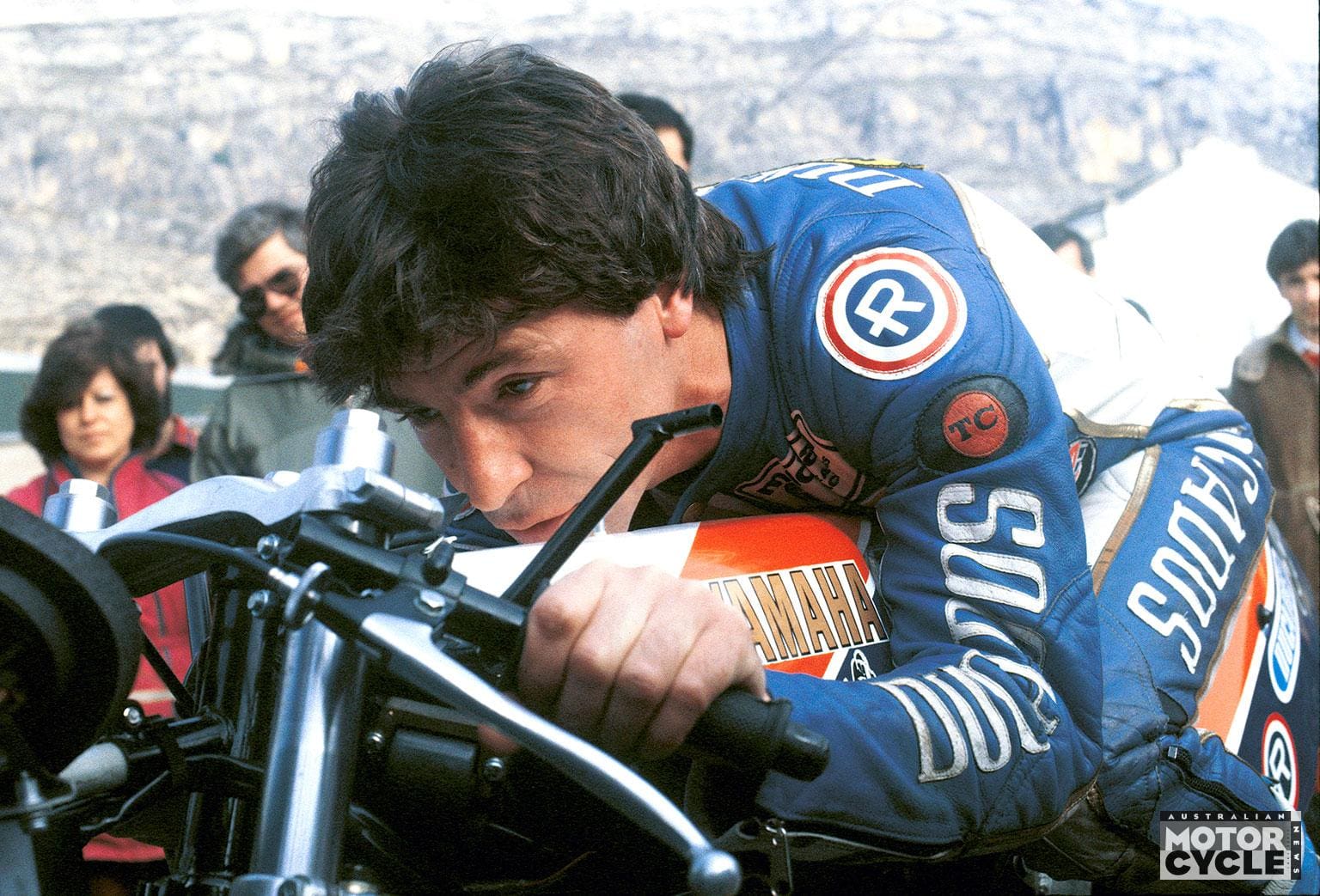When President John F. Kennedy made his momentous announcement on 25 May 1961 that the US would put a man on the moon by the end of the decade, it sparked the imagination of the entire world. It also got the propeller heads at NASA busily working away at fulfilling man’s most awesome dream.
This was uncharted territory for us earthlings, so hundreds of scientists and engineers began blue-skying all kinds of ideas to pull off what many thought had deemed impossible.
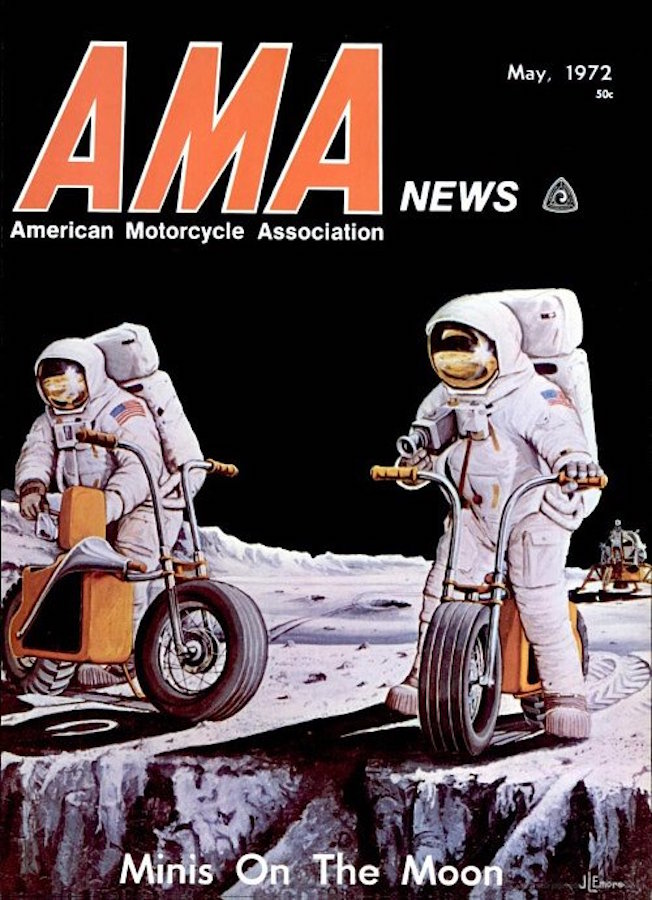
With JFK’s deadline fast approaching, one of the last things to consider was how the Apollo 11 astronauts would get around the lunar surface collecting rocks and other geological oddities before squeezing back into the Lunar Module and heading back home.
The four-wheel Lunar Rover vehicle was being developed by Boeing and General Motors’ defence research division when the Apollo 11 mission was slated to use two Saturn V rockets. But when the mission budget was cut, the second Saturn V was jettisoned and the lunar landing module idea brought in. The Rover moon buggy was deemed too large to fit into the lunar module, so the Spacecraft Design Division at Houston, Texas began toying with the idea of designing a lunar minibike that was small, lightweight and manoeuvrable.
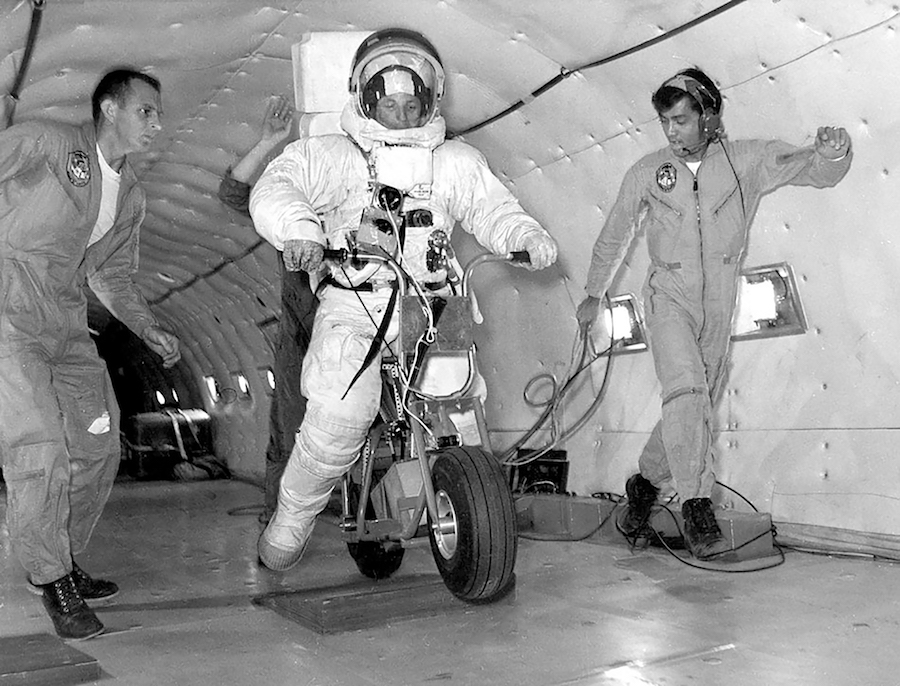
Among the exclusive astronaut cohort were men who loved the challenge of riding two wheels as well as piloting a Saturn V rocket with 7.8 million pounds of thrust. Neil Armstrong, who was destined to be the first man to walk on the moon, owned a Montesa, and the third man to follow in Armstrong’s lunar footsteps, Charles ‘Pete’ Conrad, was also a keen motorcyclist and was used as a test rider in the lunar minibike project.
With an estimated 500 million TV viewers worldwide, the PR value of having a bike on the moon would have been incalculable for the sport.
A fold-up design was sketched, but rather than build a prototype, the team did its preliminary testing with existing models. America was going through its minibike boom in the late 1960s, so there was plenty to choose from in addition to the then-new Honda CT90 step-through.
After riding the bikes over obstacles and in deep lunar-like sand, they soon discovered that the test models lacked front-end stability. Not knowing the precise topography of the moon’s surface, the team began computer-modelling the optimal front-end geometry and there appears to be an offset component mounted to fork of one of the prototypes to adjust front-end trail.
The next step was choosing tyres. The moon’s huge temperature range between day and night would put huge strains on pneumatic rubber tyres, possibly melting them during the day and cracking at night. There was the added issue of tyres deflating in space and how to re-inflate them accurately in a low-gravity atmosphere. The test team experimented with a variety of wide tyres and pressures in a vacuum chamber before it learned that the team developing the Rover vehicle was experimenting with solid metal wheels.
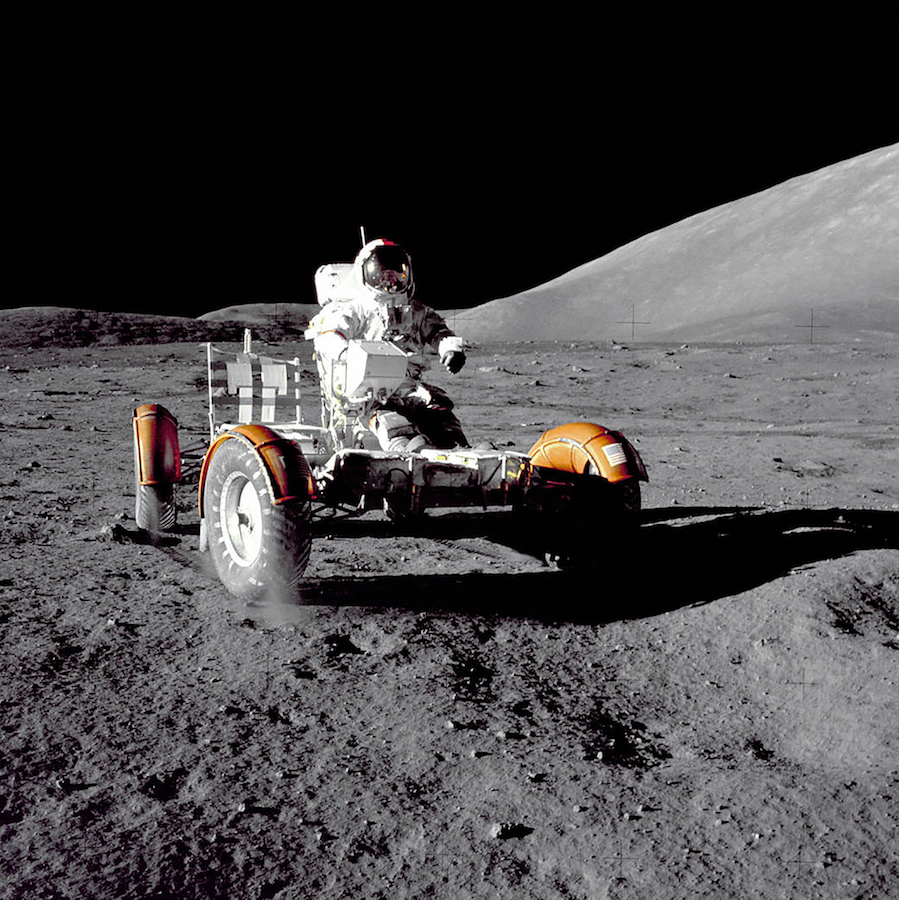
In terms of a powertrain, it was decided to use a small electric motor served by a 30-amp battery. With only five-eighths of one horsepower, the motor was good for 7mph (10km/h). Cooling would be a major problem, so the motor had special brushes and wire insulation material. The frame was designed to absorb some of the motor’s heat, and 2kg of beeswax was used to insulate the battery.
The astronauts’ pressurised spacesuits were designed for walking only, so a conventional riding position was ruled out. The idea was for the astronaut to assume an almost frontal lay-down position, with the foot pegs located rearward of the swingarm, although it was envisioned that the rider would trail his legs behind the machine “for added stability”.
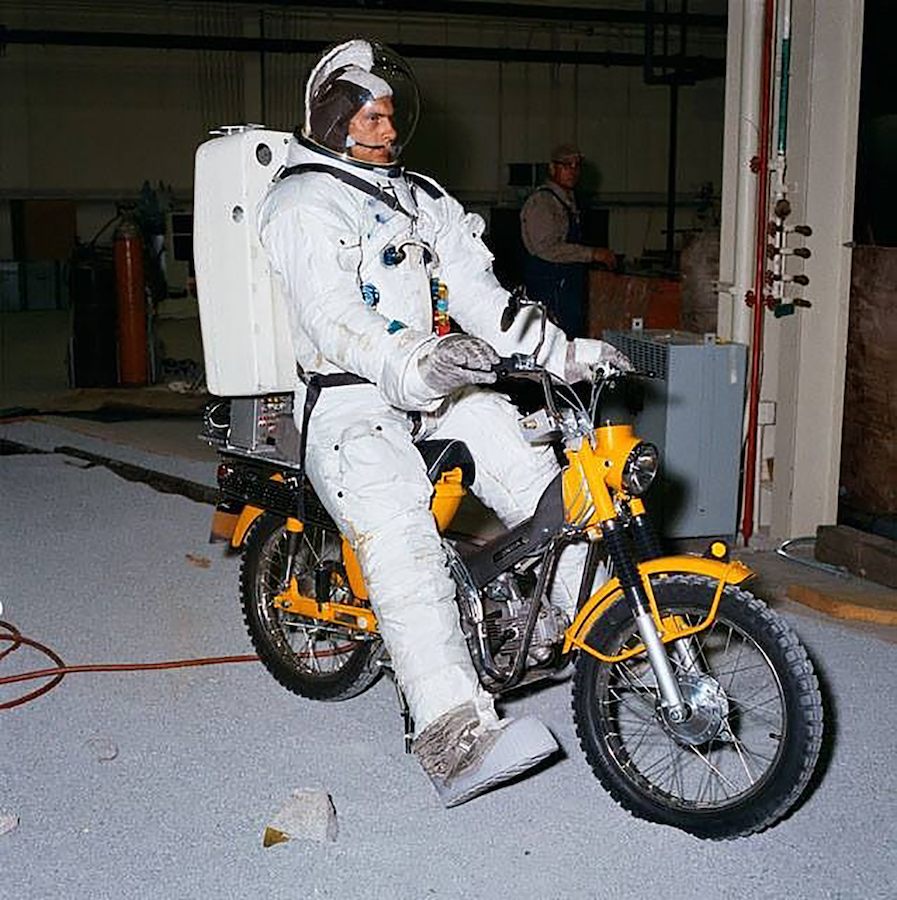
Rather than a conventional throttle assembly, the twist-grip was integrated with a gloved pod in which the rider would place his hand and operate the throttle.
The first prototypes were tested using suspension cables to simulate the level of gravity on the moon – which is not zero, as many people believe, but one-sixth that of the Earth’s – and the test riders gave the bikes a big thumbs-up. However, progress on the Rover was also positive.
Despite the apparent success of the minibike, it was deemed too unstable compared to the four-wheel vehicle because the bike needed to be leaned over much further to make it turn due to the low gravity. At least that was the theory. But if the lunar bike was only capable of 10km/h, there would be no need to lean it, just steer it with the front contact patch.
With the deadline fast approaching, neither vehicle would be ready in time for the launch of Apollo 11 in July 1969, but the $US38m Rover was given the go-ahead and scheduled for later Apollo missions.

According to American racer and writer Mark Gardner, the real reason the minibike was rejected was that it had trouble towing NASA’s planned Modular Equipment Transporter, better known as the ‘rickshaw’, which was to be part of the excavation process on the moon’s surface, carrying equipment and rock samples collected by the astronauts. However, the ‘rickshaw’ was only used on the Apollo 14 mission (31 January 1971) as a hand-pulled trolley before the Rover took over for Apollo 15 (26 July 1971).
A sad postscript to the lunar bike tale is that Conrad, at age 69 and retired, was killed after crashing his Harley-Davidson in California while out on a ride with his wife Nancy and some of their friends. It was 10 July 1999, a week before the 30th anniversary of the first successful lunar Apollo 11 mission.
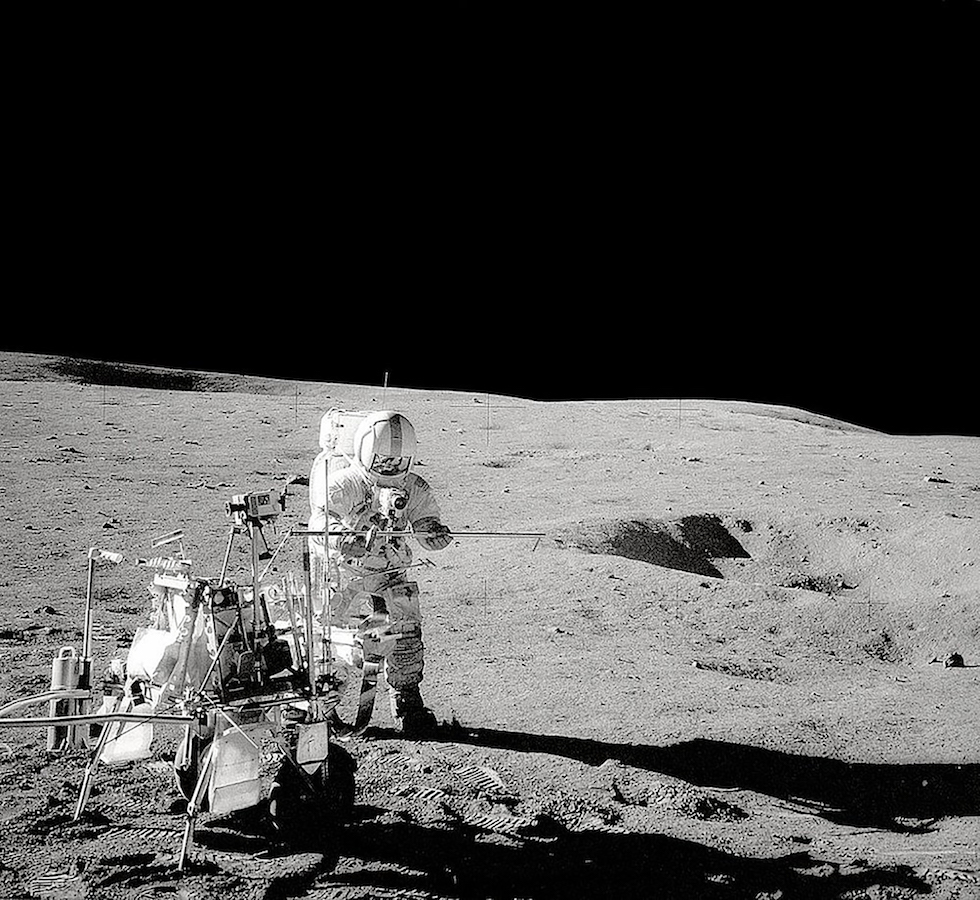
Form meets function
Build to a price, make it strong yet lightweight, and versatile yet user-specific. These are the requirements of purpose-built military motorcycles. None are too pretty, but one of the most functional and innovative was the Hägglund XM72 produced by Swedish manufacturer Hägglund & Söner. From 1973 to 1977 it was built for the Swedish Armed Forces. In 1974, a civilian version was offered.
When the Swedish army was looking for a new bike, Husqvarna and Monark responded with production-based offerings. Seizing the moment, Hägglund chief designer Bjorn Andersson sketched something entirely ahead of its time.
The prototype Hägglund XM72 featured a two-stroke 293 cc Sachs engine with automatic continuously variable V-belt transmission and a propeller shaft in the single-sided swing, making it possibly the first off-road bike to feature shaft drive. The frame consisted of a steel monocoque, the leading-link front fork running a single-arm pushed ‘short’ wheel. The front and rear wheels were interchangeable.
The production version reverted to a conventional telescopic fork and was powered by a single-cylinder, two-stroke, 345cc (76mm-square) Rotax engine. It produced 24bhp (18kW) at 5300rpm, which pushed the 135kg lightweight machine to a top speed of 120km/h.
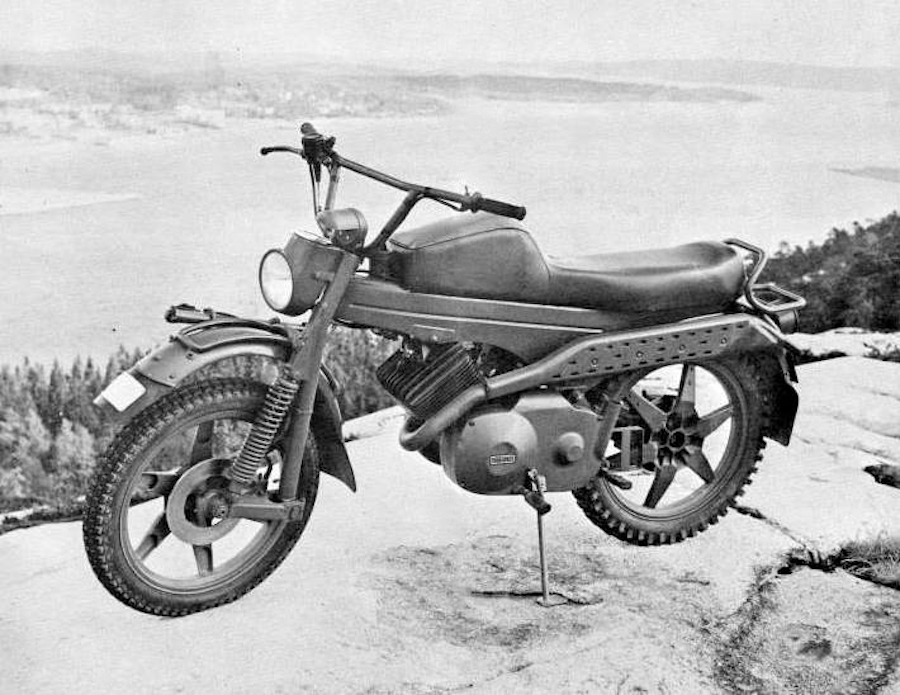
First modern scooter?
Vespa has long been credited with creating the scooter, but a little-known American manufacturer from the Badlands of Nebraska may have beaten the iconic Italian brand to the punch.
The first mass-produced scooter, the Vespa (‘Wasp’ in Italian), was created in 1946 by Piaggio, an Italian aircraft manufacturer. After the end of World War II, Piaggio had a surplus of landing wheels and wing panels, and gave its engineers a quirky but simple brief: “Develop a motorcycle which could be ridden by a woman or a priest.” And so the step-thru scooter was born. Or was it?
Founded in 1901, Cushman Motor Works made engines for industrial and farm use. One of its first engines was a two-stroke for small boats. In about 1936 Cushman decided it could sell more engines if it made a cheap, easy-to-use motorcycle, and the result was a scooter.
Cushman grew slowly on the back of its new design and made three scooter models, including the Model 53 Airborne Motor Scooter, which was parachuted out of aircraft in WWII. The step-thru design made it faster to mount and dismount, and nine out of ten US military scooters were supplied by Cushman.
After the war the Cushman scooter business boomed, until 1966 when the Honda Cub step-thru swept all before it. The company survived, though, and today makes three- and four-wheel units for schools, governments, golf courses and industrial plants.

Faking it?
Many people believe the moon landing was faked by NASA to avoid the embarrassment of being beaten by the Russians. An early and influential book on the moon-landing conspiracy, We Never Went to the Moon: America’s Thirty Billion Dollar Swindle, was self-published in 1976 by Bill Kaysing. It was followed by the 1978 film Capricorn One that starred OJ Simpson as one of the three astronauts shown walking on the ‘moon’, which was portrayed in the movie as a Hollywood sound stage.
Much of the growing scepticism was based on dozens of questions about the lunar landings, including the extremely low probability of a mission safely returning the three astronauts back to earth, their ability to withstand the heat and radiation while on the moon, the lack of a blast crater after the lunar module took off, and the lack of stars in photographs.
NASA has refuted the claims for four decades, and most recently issued validated photographs showing Apollo infrastructure left on the lunar surface and remnants of the US flags from each of the missions. Anyway, if it was all a conspiracy, why did NASA bother with the minibike project and go to the trouble of making the Parkes Observatory in central NSW its first point of communication for Neil Armstrong’s moon walk?

By DARRYL FLACK




